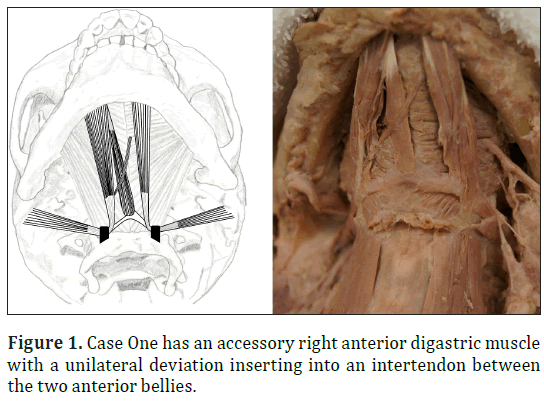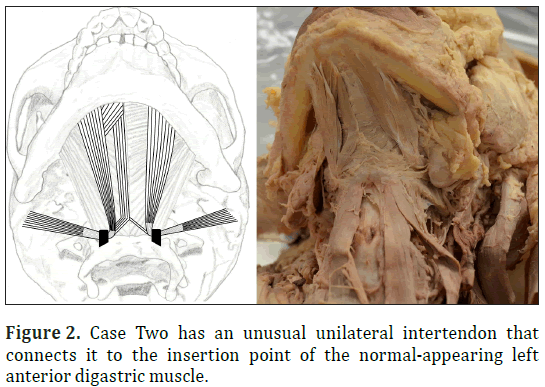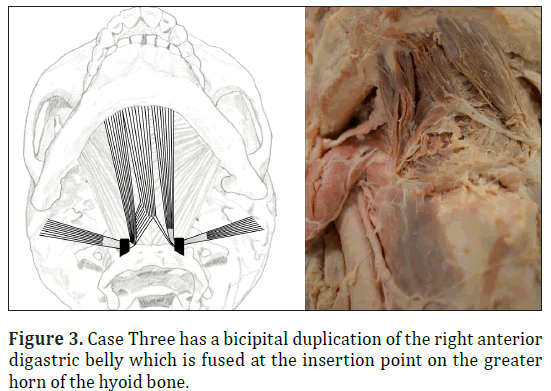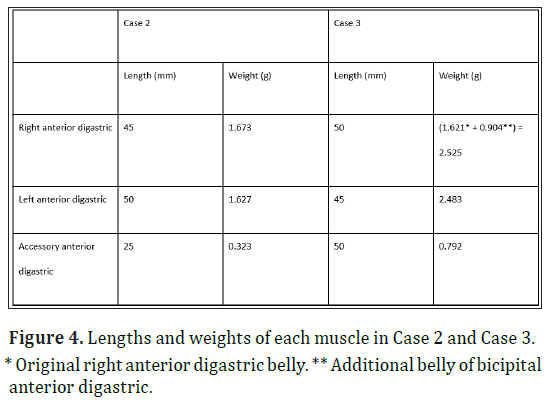Quantification of accessory digastric bellies
Courtnee R. Heyduk1, Carmen E. Allcock1 and Stuart Inglis2*
1Sanford School of Medicine, University of South Dakota, USA
2Department of Pathology and Anatomical Sciences, University at Buffalo, Buffalo, NY, USA
- *Corresponding Author:
- Stuart Inglis, PhD
206 Farber Hall (Bldg 26) Pathology and Anatomical Sciences Jacobs School of Medicine and Biomedical Sciences University at Buffalo, South Campus 3435 Main Street Buffalo NY 14214-3000, USA
Tel: +1 (716) 829-3113
E-mail: stuartin@buffalo.edu
Date of Received: November 16th, 2016
Date of Accepted: December 30th, 2016
Published Online: January 17th, 2017
© Int J Anat Var (IJAV). 2016; 9:76–78.
[ft_below_content] =>Keywords
digastric muscle, submandibular triangle, speech, tongue movement
Introduction
The digastric muscles form the lateral borders of the submental triangle, and are a component of the suprahyoid muscle group [1]. They provide a solid base for the tongue, elevate the hyoid bone and larynx during swallowing, and assist in the production of speech [1]. The anterior digastric muscle originates off the digastric fossa of the mandible, while the posterior digastric muscle attaches to the mastoid notch of the temporal bone. Both muscles insert on an intermediate tendon anchored to the greater horn of the hyoid [1].
The anterior and posterior digastric muscles arise from the first and second pharyngeal arches, respectively [2]. Like all components of the first pharyngeal arch, the anterior digastric muscle is innervated by the mandibular branch of the trigeminal nerve, specifically the nerve to mylohyoid [2]. The second pharyngeal arch is innervated by the facial nerve, CN VII, with the digastric branch innervating the posterior digastric muscle [1].
Multiple authors have written about anatomic variations in digastric muscles. In a study of 15 cadavers with variations in the anterior belly of the digastric muscle, 6 out of 15 cadavers presented with a variation in the anterior digastric muscle, where 3 of the 15 cases were unilateral [3].
In a study of 146 digastric muscle variations, five types of variants were identified [4]. Using this system, the three cases discussed in the present study would all be classified as Type II variants, defined as two bellies with extra muscular slips connected to the mandible or mylohyoid muscle. Only 4 of the 146 muscles in the original study shared this classification, representing 2.73% [4].
This case report documents these 3 uncommon cases of accessory right anterior digastric muscles. The relevance of these case reports to radiological studies and surgeries in the submental region is discussed. In addition, these muscles were measured and weighed to determine the contribution that these muscles could have on an uneven pull of the jaw which could cause pathologies later in life.
Case Report
The first involved a 79-year-old female with metastatic brain cancer. The accessory belly originated along with the right anterior digastric muscle on the mandible at the digastric fossa. This variant inserted at the midpoint of the midline raphe on an intertendon between the two anterior digastric muscle bellies (Fig. 1). There was a second minor accessory muscle which originated with the left anterior digastric and inserted with the right anterior digastric. In this donor, the major accessory belly measured 34 mm and the two anterior digastric muscles both measured 46 mm each.
The second case involved a 95-year-old female who died from congestive heart failure. The accessory belly originated along with the right anterior digastric muscle on the mandible at the digastric fossa. This variant inserted with the right anterior digastric muscle on the lesser horn of the hyoid bone (Fig. 2). In this donor, the accessory belly measured 25 mm and the right anterior digastric 45 mm and the left anterior digastric muscle was 50 mm.
The third case involved an 84-year-old male who died from renal failure secondary to coronary artery disease. This accessory belly originated more towards the midline than the right anterior digastric. The insertion was at the insertion point of the right anterior digastric. This variant also had a bicipital accessory muscle belly located anterior to the original right anterior digastric (Fig. 3). In this donor, the accessory belly measured 50 mm, the right anterior digastric muscle was 50 mm, and the left anterior digastric muscle was 45 mm.
The muscles were dissected, cleaned, and measured. Muscles were removed with as little accompanying tendon as possible. The weights of each muscle were determined on a digital scale and recorded (Fig. 4). Case One was not weighed due excessive tissue damage and dehydration prior to data collection.
Discussion
Accessory anterior digastric bellies likely arise from the first pharyngeal arch due to variations in embryological development [5]. Each of these cases have a unilateral accessory belly with intertendons which cross the midline. In addition, there are subtle differences such as the accessory muscle which crosses the midline in Case 1 and the bicipital muscle belly in Case 3.
These accessory muscles may have performed significant functions during life. Since each case was unilateral, there could be uneven wear on the surrounding structures, possibly creating undesirable pathologies. Accessory muscles could deviate the jaw to one side, which could cause bony erosions and a complete articular disc perforation in the temporomandibular joint (TMJ) over long periods of time [6]. Hyoid bone movement could also be effected, which could impact swallowing and lateral deviation of the larynx.
In order to examine this hypothesis, measurements of muscle mass and length were collected. In Case 2, there was a 5 mm difference in length between the original right and left anterior digastric muscles (Fig. 4). The weights differed by 0.046 g. In addition, the accessory muscle weighed 0.323 g and measured 25 mm. This would contribute to the overall weight and the direction of pull of the jaw from the right anterior digastric due to the similar insertion on the hyoid bone, which may cause the motion to unevenly prefer that side and possibly create pathology later in life.
In Case 3, there was also a difference of 5mm between the original right and left anterior digastric muscles (Fig. 4). The weight difference was 0.862 g. The accessory muscle weighed 0.792 g and measured 50 mm, which was the same length as the original right anterior digastric. The bicipital belly weighed 0.904 g. This case is unique in that it contained a bicipital muscle belly which was attached to the original right anterior digastric muscle, which would have contributed to the overall weight on that side. In addition, the accessory muscle belly inserted along with the original right anterior digastric on the hyoid bone, which could have assisted in rightward deviation of the jaw.
Knowing the wide range of variability of these accessory muscles is important for surgeons and radiologists to avoid errors in identification during surgery, especially as the anterior digastric muscle is used as a landmark for identifying the lingual nerve and the duct of the submandibular salivary gland [7]. The muscle may also be mistaken for a pseudomass or and infarcted or metastatic lymph node on radiological scans [7]. Knowing the wide range of variations that are relatively common in this particular region is important to avoid misdiagnosis in scanning and surgery.
Acknowledgement
We would like to thank USD anatomy course of Fall 2015 for reporting the cases and performing initial dissections. The authors wish to thank individuals who donate their bodies and tissues for the advancement of education and research.
References
- Moore KL, Agur AMR, Dalley AF. Clinically Oriented Anatomy. 7th Ed., Baltimore Lippincott Williams & Wilkins. 2014; 999-1067
- Sadler T. Langman J. Langman’s Medical Embryology. 12th Ed., Philadelphia Wolters Kluwer Health/Lippincott Williams & Wilkins. 2012; 262-264.
- Mangalagiri AS, Razvi MRA. Variations in the anterior belly of diagastric. Int J Health Sci. 2009; 3(2): 257-262.
- De-Ary-Pires B, Ary-Pires R, Pires-Neto M. The human digastric muscle: patterns and variations with clinical and surgical correlations. Ann Anat. 2003; 185: 471-479.
- Karunakaran I, Dhingra R, Dhar P. Accessory digastric and mylohyoid muscles - a case report. Int J Anat Var (IJAV). 2013; 6: 179-181.
- Stockstill J, Harn S, Underhill T. Clinical Implications of Anomalous Muscle insertion relative to jaw movement and mandibular dysfunction: The anterior belly of the digastric muscle in a cadaver. J Craniomandib Disord. 1991; 5(1): 64-70.
- Rani A, Chopra J, Rani A, Verma RK. Duplicated anterior belly of the digastric muscle. Singapore Med J. 2013; 54(6): 131-132.
Courtnee R. Heyduk1, Carmen E. Allcock1 and Stuart Inglis2*
1Sanford School of Medicine, University of South Dakota, USA
2Department of Pathology and Anatomical Sciences, University at Buffalo, Buffalo, NY, USA
- *Corresponding Author:
- Stuart Inglis, PhD
206 Farber Hall (Bldg 26) Pathology and Anatomical Sciences Jacobs School of Medicine and Biomedical Sciences University at Buffalo, South Campus 3435 Main Street Buffalo NY 14214-3000, USA
Tel: +1 (716) 829-3113
E-mail: stuartin@buffalo.edu
Date of Received: November 16th, 2016
Date of Accepted: December 30th, 2016
Published Online: January 17th, 2017
© Int J Anat Var (IJAV). 2016; 9:76–78.
Abstract
Accessory right anterior digastric muscles were found in three cadavers in the dissection lab of the Sanford School of Medicine during the 2012-2015 school years. These were dissected, photographed, measured, and then removed for weighing. Weights were used to hypothesize contractile forces for each muscle. It is important to continue to document these accessory muscles and their variations, as they are important landmarks in surgery and may be mistakenly identified on radiological scans.
-Keywords
digastric muscle, submandibular triangle, speech, tongue movement
Introduction
The digastric muscles form the lateral borders of the submental triangle, and are a component of the suprahyoid muscle group [1]. They provide a solid base for the tongue, elevate the hyoid bone and larynx during swallowing, and assist in the production of speech [1]. The anterior digastric muscle originates off the digastric fossa of the mandible, while the posterior digastric muscle attaches to the mastoid notch of the temporal bone. Both muscles insert on an intermediate tendon anchored to the greater horn of the hyoid [1].
The anterior and posterior digastric muscles arise from the first and second pharyngeal arches, respectively [2]. Like all components of the first pharyngeal arch, the anterior digastric muscle is innervated by the mandibular branch of the trigeminal nerve, specifically the nerve to mylohyoid [2]. The second pharyngeal arch is innervated by the facial nerve, CN VII, with the digastric branch innervating the posterior digastric muscle [1].
Multiple authors have written about anatomic variations in digastric muscles. In a study of 15 cadavers with variations in the anterior belly of the digastric muscle, 6 out of 15 cadavers presented with a variation in the anterior digastric muscle, where 3 of the 15 cases were unilateral [3].
In a study of 146 digastric muscle variations, five types of variants were identified [4]. Using this system, the three cases discussed in the present study would all be classified as Type II variants, defined as two bellies with extra muscular slips connected to the mandible or mylohyoid muscle. Only 4 of the 146 muscles in the original study shared this classification, representing 2.73% [4].
This case report documents these 3 uncommon cases of accessory right anterior digastric muscles. The relevance of these case reports to radiological studies and surgeries in the submental region is discussed. In addition, these muscles were measured and weighed to determine the contribution that these muscles could have on an uneven pull of the jaw which could cause pathologies later in life.
Case Report
The first involved a 79-year-old female with metastatic brain cancer. The accessory belly originated along with the right anterior digastric muscle on the mandible at the digastric fossa. This variant inserted at the midpoint of the midline raphe on an intertendon between the two anterior digastric muscle bellies (Fig. 1). There was a second minor accessory muscle which originated with the left anterior digastric and inserted with the right anterior digastric. In this donor, the major accessory belly measured 34 mm and the two anterior digastric muscles both measured 46 mm each.
The second case involved a 95-year-old female who died from congestive heart failure. The accessory belly originated along with the right anterior digastric muscle on the mandible at the digastric fossa. This variant inserted with the right anterior digastric muscle on the lesser horn of the hyoid bone (Fig. 2). In this donor, the accessory belly measured 25 mm and the right anterior digastric 45 mm and the left anterior digastric muscle was 50 mm.
The third case involved an 84-year-old male who died from renal failure secondary to coronary artery disease. This accessory belly originated more towards the midline than the right anterior digastric. The insertion was at the insertion point of the right anterior digastric. This variant also had a bicipital accessory muscle belly located anterior to the original right anterior digastric (Fig. 3). In this donor, the accessory belly measured 50 mm, the right anterior digastric muscle was 50 mm, and the left anterior digastric muscle was 45 mm.
The muscles were dissected, cleaned, and measured. Muscles were removed with as little accompanying tendon as possible. The weights of each muscle were determined on a digital scale and recorded (Fig. 4). Case One was not weighed due excessive tissue damage and dehydration prior to data collection.
Discussion
Accessory anterior digastric bellies likely arise from the first pharyngeal arch due to variations in embryological development [5]. Each of these cases have a unilateral accessory belly with intertendons which cross the midline. In addition, there are subtle differences such as the accessory muscle which crosses the midline in Case 1 and the bicipital muscle belly in Case 3.
These accessory muscles may have performed significant functions during life. Since each case was unilateral, there could be uneven wear on the surrounding structures, possibly creating undesirable pathologies. Accessory muscles could deviate the jaw to one side, which could cause bony erosions and a complete articular disc perforation in the temporomandibular joint (TMJ) over long periods of time [6]. Hyoid bone movement could also be effected, which could impact swallowing and lateral deviation of the larynx.
In order to examine this hypothesis, measurements of muscle mass and length were collected. In Case 2, there was a 5 mm difference in length between the original right and left anterior digastric muscles (Fig. 4). The weights differed by 0.046 g. In addition, the accessory muscle weighed 0.323 g and measured 25 mm. This would contribute to the overall weight and the direction of pull of the jaw from the right anterior digastric due to the similar insertion on the hyoid bone, which may cause the motion to unevenly prefer that side and possibly create pathology later in life.
In Case 3, there was also a difference of 5mm between the original right and left anterior digastric muscles (Fig. 4). The weight difference was 0.862 g. The accessory muscle weighed 0.792 g and measured 50 mm, which was the same length as the original right anterior digastric. The bicipital belly weighed 0.904 g. This case is unique in that it contained a bicipital muscle belly which was attached to the original right anterior digastric muscle, which would have contributed to the overall weight on that side. In addition, the accessory muscle belly inserted along with the original right anterior digastric on the hyoid bone, which could have assisted in rightward deviation of the jaw.
Knowing the wide range of variability of these accessory muscles is important for surgeons and radiologists to avoid errors in identification during surgery, especially as the anterior digastric muscle is used as a landmark for identifying the lingual nerve and the duct of the submandibular salivary gland [7]. The muscle may also be mistaken for a pseudomass or and infarcted or metastatic lymph node on radiological scans [7]. Knowing the wide range of variations that are relatively common in this particular region is important to avoid misdiagnosis in scanning and surgery.
Acknowledgement
We would like to thank USD anatomy course of Fall 2015 for reporting the cases and performing initial dissections. The authors wish to thank individuals who donate their bodies and tissues for the advancement of education and research.
References
- Moore KL, Agur AMR, Dalley AF. Clinically Oriented Anatomy. 7th Ed., Baltimore Lippincott Williams & Wilkins. 2014; 999-1067
- Sadler T. Langman J. Langman’s Medical Embryology. 12th Ed., Philadelphia Wolters Kluwer Health/Lippincott Williams & Wilkins. 2012; 262-264.
- Mangalagiri AS, Razvi MRA. Variations in the anterior belly of diagastric. Int J Health Sci. 2009; 3(2): 257-262.
- De-Ary-Pires B, Ary-Pires R, Pires-Neto M. The human digastric muscle: patterns and variations with clinical and surgical correlations. Ann Anat. 2003; 185: 471-479.
- Karunakaran I, Dhingra R, Dhar P. Accessory digastric and mylohyoid muscles - a case report. Int J Anat Var (IJAV). 2013; 6: 179-181.
- Stockstill J, Harn S, Underhill T. Clinical Implications of Anomalous Muscle insertion relative to jaw movement and mandibular dysfunction: The anterior belly of the digastric muscle in a cadaver. J Craniomandib Disord. 1991; 5(1): 64-70.
- Rani A, Chopra J, Rani A, Verma RK. Duplicated anterior belly of the digastric muscle. Singapore Med J. 2013; 54(6): 131-132.










